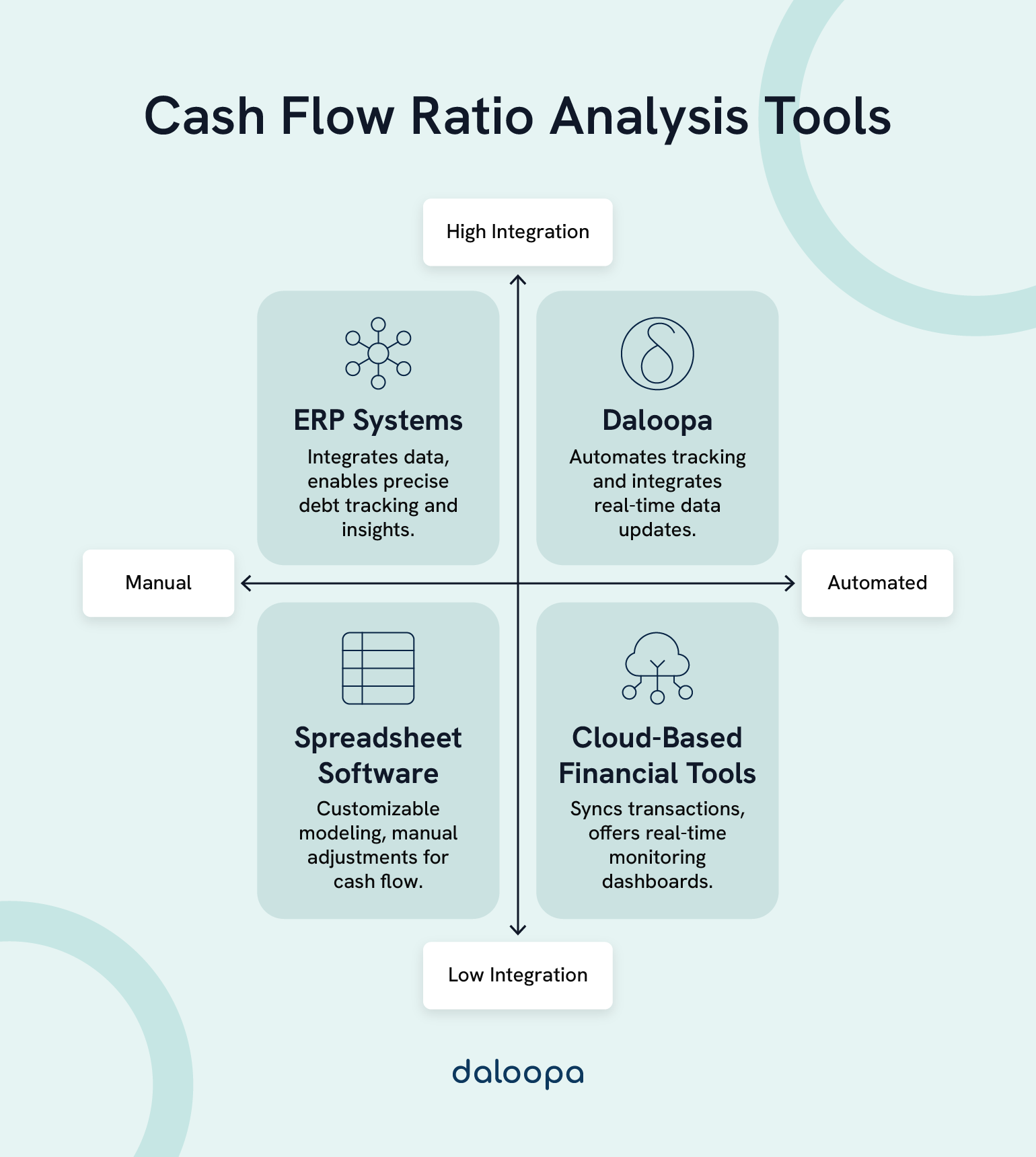Many businesses look profitable on paper—until they run out of cash. Like a silent thief in the night, poor cash flow can cripple even the most seemingly successful ventures. Cash flow ratios act as your financial detectives, uncovering these hidden dangers before it’s too late, providing a crucial x-ray into a company’s true financial health that traditional balance sheets and income statements often miss.
These metrics delve deeper than surface-level figures, revealing the actual cash-generating muscle of your business. By mastering cash flow ratio analysis, you gain real-time insights into liquidity, operational efficiency, and long-term financial stability, giving you the power to navigate the complex world of finance with confidence.
Key Takeaways
- Cash flow ratios tools for financial analysis provide insights into financial health that traditional financial statements may not fully capture.
- Advanced financial ratio analysis software allows for real-time monitoring of cash movements, aiding strategic decision-making.
- Operating cash flow metrics serve as early warning signs for liquidity constraints and long-term solvency concerns.
Key Cash Flow Ratios for Financial Analysis
Cash flow ratios tools for financial analysis serve as critical indicators of a company’s financial stability and ability to meet obligations. These metrics provide a deeper understanding of liquidity, operational efficiency, and financial sustainability.
Free Cash Flow Ratio
The Free Cash Flow (FCF) ratio measures a company’s ability to generate cash after covering capital expenditures, offering insights into financial flexibility and growth potential.
Formula:
FCF Ratio = Free Cash Flow / Operating Cash Flow
A higher FCF ratio signals robust cash generation, bolstering financial stability. Regularly tracking this ratio, ideally quarterly, allows you to spot trends and shifts in financial health, enabling proactive adjustments to your strategy. By leveraging financial ratio analysis software, companies can gain deeper insights into cash flow ratio analysis trends. For example, a company with an FCF ratio below 0.1 may struggle to reinvest in its operations or distribute dividends, potentially requiring external financing. Conversely, a tech startup with a high FCF ratio has the financial firepower to aggressively scale its operations without diluting existing ownership.
Key factors in FCF analysis include:
- Stability of Operating Cash Flow: Consistent cash flow from core operations is crucial for long-term financial health.
- Capital Expenditure Requirements: Understanding the necessary investments in assets and infrastructure is essential for accurate FCF calculations.
- Efficiency in Managing Working Capital: Optimizing the management of current assets and liabilities directly impacts free cash flow.
- Financial Flexibility for Reinvestment or Debt Reduction: A healthy FCF provides options for reinvesting in growth or paying down debt, strengthening the financial foundation of the business. Daloopa’s platform can help analyze and visualize these factors, providing a comprehensive understanding of a company’s FCF dynamics.
Cash Flow Coverage Ratio
The Cash Flow Coverage Ratio evaluates whether a company can meet debt obligations using its cash flow from operations, making it a crucial metric for assessing credit risk and debt serviceability.
Formula:
Coverage Ratio = Operating Cash Flow / Total Debt Service
A ratio above 1.0 indicates sufficient cash flow to cover debt payments. Financially robust companies often maintain a ratio of 1.5 or higher, providing a safety cushion against unexpected downturns. A ratio below 1.0 signals potential trouble, suggesting the company may struggle to meet its debt obligations. Cash flow ratios tools for financial analysis help companies monitor these metrics and avoid potential liquidity crises.
Key elements to monitor:
- Interest Payment Obligations: Understanding the interest burden is crucial for assessing debt serviceability.
- Principal Repayment Schedules: Knowing the timing and amount of principal repayments is essential for cash flow planning.
- Stability of Cash Flow from Operations: Consistent operating cash flow is key to meeting debt obligations reliably.
Operating Cash Flow Ratios
Operating cash flow ratios measure short-term liquidity and operational efficiency, helping assess a company’s ability to manage working capital and convert revenue into cash.
Key operating ratios include:
- Operating Cash Flow / Current Liabilities: Measures liquidity strength.
- Operating Cash Flow / Total Assets: Evaluate cash efficiency in asset utilization.
- Operating Cash Flow / Sales: Determines cash conversion efficiency relative to revenue.
By integrating financial ratio analysis software, businesses can automate tracking of these cash flow ratio analysis metrics for better financial management.
Target benchmarks for financial health:
| Ratio | Strong Performance |
| OCF/Current Liabilities | > 0.4 |
| OCF/Total Assets | > 0.2 |
| OCF/Sales | > 0.1 |
Regularly tracking these ratios helps pinpoint operational strengths and potential cash flow constraints.

Technology Platforms & Software for Cash Flow Analysis
Advanced financial ratio analysis software simplifies cash flow ratio analysis, automating calculations and offering real-time insights for better decision-making.
Cloud-Based Financial Analysis Tools
Platforms like Daloopa streamline cash flow management by automatically syncing transactions and categorizing cash movements.
Key features include:
- Automated cash flow ratios tools for financial analysis
- Real-time dashboards for financial monitoring
- AI-driven forecasting based on historical trends
- Integration with payment processing systems for cash flow visibility
These tools help businesses maintain financial oversight and detect potential liquidity issues early.
Spreadsheet Models & Custom Calculators
While cloud-based platforms offer convenience, traditional spreadsheet software like Microsoft Excel and Google Sheets remain valuable tools for creating custom cash flow ratio analysis models. Their flexibility allows for tailored financial analysis using built-in formulas and templates.
Key functionalities:
- Pre-set financial functions for ratio calculations
- Scenario analysis tools for forecasting
- Data validation to ensure accuracy
- Automated reporting for streamlined financial oversight
Spreadsheets enable businesses to customize models according to industry-specific requirements and strategic objectives.
ERP & Financial Management Software Integration
Enterprise Resource Planning (ERP) systems like SAP and Oracle offer comprehensive cash flow analysis capabilities by consolidating financial data from various departments across the organization. These systems provide a holistic view of cash flow, enabling more informed decision-making.
Key integration features:
- Automatic data imports from accounts receivable and payable
- Real-time cash position tracking across business operations
- Advanced forecasting tools to support strategic decision-making
By integrating financial data, ERP systems provide a holistic view of a company’s cash flow, enhancing working capital management and planning. Daloopa integrates with various ERP and financial management systems, providing enhanced cash flow analytics and insights.
Advantages of Cash Flow Ratio Analysis Over Traditional Financial Metrics
Cash flow ratios offer a more accurate view of a company’s financial standing by tracking real cash movement rather than relying on accounting-based earnings reports.
Real-Time Financial Health Assessment
Unlike profit-based metrics, cash flow ratios reveal how well a company can sustain operations, pay off obligations, and invest in growth. They provide an unfiltered look at liquidity and efficiency.
- Operating Cash Flow Ratios: Measure a company’s ability to cover short-term liabilities.
- Cash Flow Coverage Ratios: Assess whether a business generates enough cash to meet debt payments.
- Free Cash Flow Ratios: Highlight a company’s capacity to fund expansion without external financing.
These insights allow businesses to respond swiftly to financial challenges and opportunities.
Detecting Problems Before They Escalate
Cash flow ratio analysis uncovers financial challenges earlier than traditional reports, providing a real-time assessment of cash movement.
- Cash Flow-to-debt Ratios: Identify potential solvency risks by analyzing how well-operating cash supports debt repayment.
- Free Cash Flow Ratios: Indicate whether a business has the flexibility to grow sustainably.
- Operating Cash Flow Margins: Help detect declining efficiency before profitability takes a hit.
By monitoring these metrics, businesses can proactively adjust strategies to maintain financial health.
Strategic Decision-Making with Cash Flow Ratio Tools
A well-rounded cash flow analysis strengthens financial decision-making, helping businesses maintain stability and pursue growth with confidence.
Ensuring Business Growth & Stability
- Operating Cash Flow to Net Income Ratio: Gauges earnings quality by comparing actual cash flow with reported profits. A ratio above 1.0 suggests a strong financial foundation.
- Free Cash Flow Yield: Helps determine whether a company has enough cash for expansion while maintaining stable operations.
- Cash Flow Coverage Ratio: Assesses the ability to meet short-term obligations, ensuring financial resilience.
Enhancing Profitability & Managing Risk
- Cash Flow to Debt Ratio: Signals whether a company generates enough cash to service its debt, with a target of 0.20 or higher indicating healthy financial management.
- Operating Cash Flow Margin: Tracks the efficiency of converting revenue into cash, helping companies refine cost structures.
- Cash Flow Return on Assets: Evaluates how well a company utilizes its asset base to generate cash, guiding capital investment decisions.
Additionally, monitoring cash flow volatility trends helps businesses anticipate operational risks and market fluctuations, ensuring financial preparedness.
Mastering cash flow ratios tools for financial analysis is essential for businesses that want to stay ahead in an unpredictable financial landscape. By leveraging these insights, companies can enhance liquidity, optimize resource allocation, and make informed strategic decisions. Whether through financial ratio analysis software or traditional models, tracking cash flow metrics is key to long-term stability and growth.
Ready to Take Control of Your Financial Future?
Daloopa offers cutting-edge cash flow analysis tools and insights, empowering businesses to make informed decisions, optimize financial performance, and achieve sustainable growth. Request a demo to learn more about how we can transform your financial planning and analysis.



